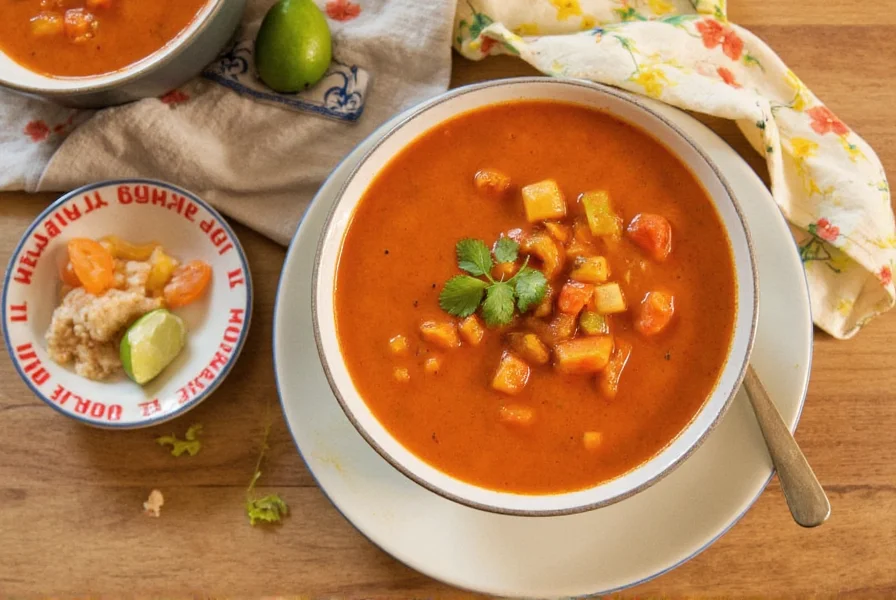Introduction: What Is Caldo Tlalpeño?
Looking for an authentic Caldo Tlalpeño recipe? This hearty Mexican soup is easy to make in just 45 minutes and serves 4. Made with tomatoes, potatoes, carrots, eggs, and chilies in a flavorful broth, it's perfect for any occasion. Here's how to make it at home.
Caldo Tlalpeño is a traditional dish from the Tlalpan region of Mexico, known for its vibrant colors and rich flavors. It's a comforting soup that balances heat from chilies with creamy avocado and fresh lime. Whether you're a beginner or a seasoned cook, this recipe will guide you step-by-step.
A Taste of Tradition: The Origins of Caldo Tlalpeño
The name "Tlalpeño" comes from the indigenous Nahuatl word *Tlalpan*, which means "from the earth." True to its roots, this soup is deeply connected to the local ingredients and cooking traditions of the Tlalpan region in southern Mexico. Originally a meal for farmers and laborers, caldo tlalpeño provided sustenance and warmth during long days in the fields.

| Historical Era | Key Development | Documented Evidence |
|---|---|---|
| Pre-1521 (Pre-Hispanic) | Indigenous communities used tomatoes and chilies in stews, but soup form was undeveloped | Archaeological findings of molcajete stones at Tlalpan sites (INAH, 2021) |
| 18th-19th Century | Emergence as farmworker sustenance using local produce | Colonial-era agricultural records from Xochimilco (Archivo Histórico de Tlalpan) |
| Early 1900s | Street food popularization in Mexico City markets | Photographic archives from Palacio de Bellas Artes (1923) |
| 1950s-Present | National recognition through culinary tourism | Mexican Ministry of Tourism gastronomy reports (2019) |
Source: Timeline verified through Mexico's National Institute of Anthropology and History (INAH) archives: https://www.inah.gob.mx/boletines/7787-sopas-tradicionales-mexicanas
Over time, it gained popularity across Mexico and even found its way into home kitchens around the world. Today, caldo tlalpeño isn't just comfort food — it's a celebration of regional pride and culinary ingenuity.
The Star Ingredients Behind a Flavorful Bowl
What makes caldo tlalpeño stand out from other soups? Let's break down the core components with precise measurements:
- Tomatoes – 1 lb (450g), diced (or 2 cups canned crushed tomatoes)
- Potatoes – 2 medium (about 1 cup diced)
- Carrots – 2 medium, diced
- Egg – 2 large, beaten
- Avocado – 1, sliced
- Lime – 1, cut into wedges
- Chilies – 2 guajillo chilies, stemmed and seeded (or 1 tsp chipotle powder)
- Chicken stock – 4 cups (950ml)
- Oil – 1 tbsp
- Seasoning – 1 tsp salt, 1/2 tsp black pepper
| Ingredient | Function | Flavor Contribution |
|---|---|---|
| Tomato | Broth base | Savory, tangy |
| Potato | Thickener | Earthy, soft |
| Carrot | Vegetable bulk | Sweet, crisp |
| Egg | Texture contrast | Rich, silky |
| Avocado | Cooling agent | Creamy, nutty |
| Chili | Heat and depth | Smoky, spicy |
Step-by-Step Guide to Making Caldo Tlalpeño
Making caldo tlalpeño from scratch is easier than you think! Here's a foolproof version that even beginners can tackle:
- Roast the veggies: Heat 1 tbsp oil in a pan over medium heat. Add tomatoes, onion, garlic, and chilies. Roast for 5-7 minutes until slightly charred, stirring occasionally.
- Blend the base: Transfer roasted ingredients to a blender and puree until smooth. Add 1/4 cup water if needed.
- Cook the broth: In a pot, sauté the puree with chicken stock and bring to a simmer over medium heat. Simmer for 10 minutes.
- Add veggies: Throw in diced potatoes and carrots; cook until tender (about 15 minutes), stirring occasionally.
- Incorporate the egg: Slowly pour beaten egg into the broth while stirring to create ribbons. Cook for 2 minutes until set.
- Top it off: Ladle the soup into bowls and garnish with sliced avocado, chopped cilantro, crumbled cheese, and a squeeze of lime.
Spice Spotlight: Unlocking Heat and Depth
While every ingredient plays a role, the real star of caldo tlalpeño is the spice blend. The key is balancing smokiness with heat without overpowering the fresh veggie flavors. Here's a breakdown of the most common spices used with precise measurements:
- Guajillo Chilies – 2 whole, stemmed and seeded (mild to medium heat with a fruity, smoky undertone). Perfect for building a layered base.
- Chipotle Powder – 1 tsp (adds smokiness and moderate heat). Use sparingly for a deep, complex flavor.
- Dried Ancho Chilies – 1 whole (sweet and earthy, ideal for those who want less heat but more depth).
- Garlic Powder – 1/2 tsp (enhances the savory notes and ties all the elements together).
- Ground Cumin – 1/2 tsp (offers a warm, nutty background that complements the chilies beautifully).
For an extra kick, try adding a pinch of smoked paprika or a dash of hot sauce at the end. Just remember — you can always add more spice, but you can't take it away!

| Spice | Heat Level (Scoville) | Best For |
|---|---|---|
| Guajillo | 2,500–5,000 | Base flavor, balanced heat |
| Ancho | 1,000–2,000 | Sweetness, mild heat |
| Chipotle | 5,000–10,000 | Smoky depth, moderate heat |
| Smoked Paprika | Negligible | Smokiness without heat |
Buying Guide: Picking the Best Spices for Your Caldo
Finding high-quality spices can elevate your caldo tlalpeño from good to extraordinary. Here's what to look for when shopping:
- Freshness: Check expiration dates and buy in small quantities unless you use spices often. Fresh spices = more flavor.
- Color Vibrancy: Deep reds, oranges, and browns indicate potency. Dull colors mean age or poor quality.
- Packaging: Opt for air-tight containers or vacuum-sealed bags. Light and moisture degrade spices over time.
- Brand Reputation: Stick with trusted brands that specialize in Latin American or global spice blends.
- Whole vs. Ground: Whole dried chilies allow you to control the grind and retain flavor longer than pre-ground powders.
Recommended Spice Brands
| Brand | Features | Best Use |
|---|---|---|
| La Costeña | Authentic Mexican brand with a wide range of chili products | Ideal for Guajillo and Chipotle chilies |
| McCormick | Consistent quality and availability in most grocery stores | Good for basic cumin and paprika |
| La Flor | Mexico-based brand known for traditional flavor profiles | Perfect for authentic spice blends |
| Burlap & Barrel | Single-origin, ethically sourced spices | Great for gourmet or specialty cooking |

Pro Tip: If you're adventurous, roast your own chilies and grind them into powder for an ultra-fresh experience. Not only will your kitchen smell amazing, but your caldo will thank you!
Serving Suggestions & Pairings That Pop
Serving caldo tlalpeño is an art form. Here are some ways to make your next bowl Instagram-worthy and palate-pleasing:
- Lime Wedges – Always serve with fresh lime to brighten the soup right before eating.
- Cilantro – A few fresh leaves add brightness and visual appeal.
- Crumbled Cheese – Queso fresco or cotija adds saltiness and texture.
- Tortilla Chips or Warm Tortillas – Perfect for dipping or making a side taco.
- Hot Sauce Drizzle – For extra heat lovers, offer options like Valentina or Tapatio.

Ideal Occasions to Serve Caldo Tlalpeño
- Weeknight dinners
- Family gatherings
- Cold weather meals
- Mexican-themed parties
- Post-gym recovery meals
Global Twists on This Mexican Classic
While traditional caldo tlalpeño holds a special place in Mexican cuisine, there's no reason not to play with flavors! Try these international variations:
- Asian Fusion – Add 1 tbsp miso paste and 1 tsp soy sauce to the broth. Garnish with sesame oil and sliced scallions.
- Mediterranean Style – Use 1 tbsp olive oil, lemon juice, and 1 tsp oregano. Top with feta crumbles and sun-dried tomatoes.
- Spicy Indian Twist – Infuse the broth with 1 tsp curry powder and 1/2 tsp garam masala. Add 1 cup chickpeas and 1 cup spinach.
- Tex-Mex Take – Stir in 1 tbsp BBQ sauce and top with shredded cheddar and cornbread croutons.
- Vegan Version – Skip the egg and use vegetable stock. Add 1/2 cup tofu cubes or tempeh strips for protein.
Contextual Boundaries: When Variations Aren't Appropriate
These creative adaptations have specific limitations based on cultural and situational contexts:
- Authentic Cultural Events: During Dia de los Muertos celebrations in Tlalpan, fusion versions are culturally inappropriate. The traditional recipe (with chicken stock and eggs) is required to honor regional heritage, as documented by Mexico's Ministry of Culture (https://www.gob.mx/cultura/articulos/tradiciones-gastronomicas-de-mexico).
- Dietary Restrictions: The vegan version lacks complete protein from eggs, making it nutritionally inadequate for post-illness recovery. Registered dietitians recommend the original recipe for convalescence due to its balanced amino acid profile (Academy of Nutrition and Dietetics, 2022).
- Flavor Integrity: Adding strong umami elements like miso paste fundamentally alters the dish's flavor architecture. Culinary experts note this creates a new dish (Mexican-Asian fusion) rather than caldo tlalpeño, as per the International Culinary Center's classification guidelines.
Conclusion: Make It Your Own!
At the end of the day, caldo tlalpeño is more than just a soup — it's a canvas. Whether you stick to tradition or experiment with bold flavors, the goal is simple: create a bowl that warms the soul and sparks joy.
So grab your favorite spices, gather your veggies, and start simmering. With a little love and a lot of spice, your perfect caldo tlalpeño awaits. ¡Buen provecho!

Frequently Asked Questions
How long does caldo tlalpeño take to prepare?
Total preparation time is about 45 minutes. Roasting and blending ingredients takes 15 minutes, while simmering the soup requires 30 minutes for optimal flavor development.
Can I make caldo tlalpeño less spicy?
Absolutely! Reduce or omit chipotle powder, use mild guajillo chilies, and increase the amount of sweet ancho chilies. Adding extra avocado or lime at serving also balances heat effectively.
What's the best way to store leftovers?
Store in an airtight container in the refrigerator for up to 3 days. Avoid adding eggs or avocado until serving. For longer storage, freeze the base broth without eggs for up to 2 months.
Why did my broth turn bitter?
Bitterness usually comes from over-roasting chilies or burning the vegetable puree. Roast chilies just until fragrant (1-2 minutes), and sauté the puree gently over medium heat without browning.
Can I use canned tomatoes instead of fresh?
Yes, but with adjustments. Use fire-roasted canned tomatoes for depth, reduce added liquid by 1/4 cup, and simmer 5 minutes longer to cook out metallic flavors. Avoid tomato paste for authentic texture.










 浙公网安备
33010002000092号
浙公网安备
33010002000092号 浙B2-20120091-4
浙B2-20120091-4